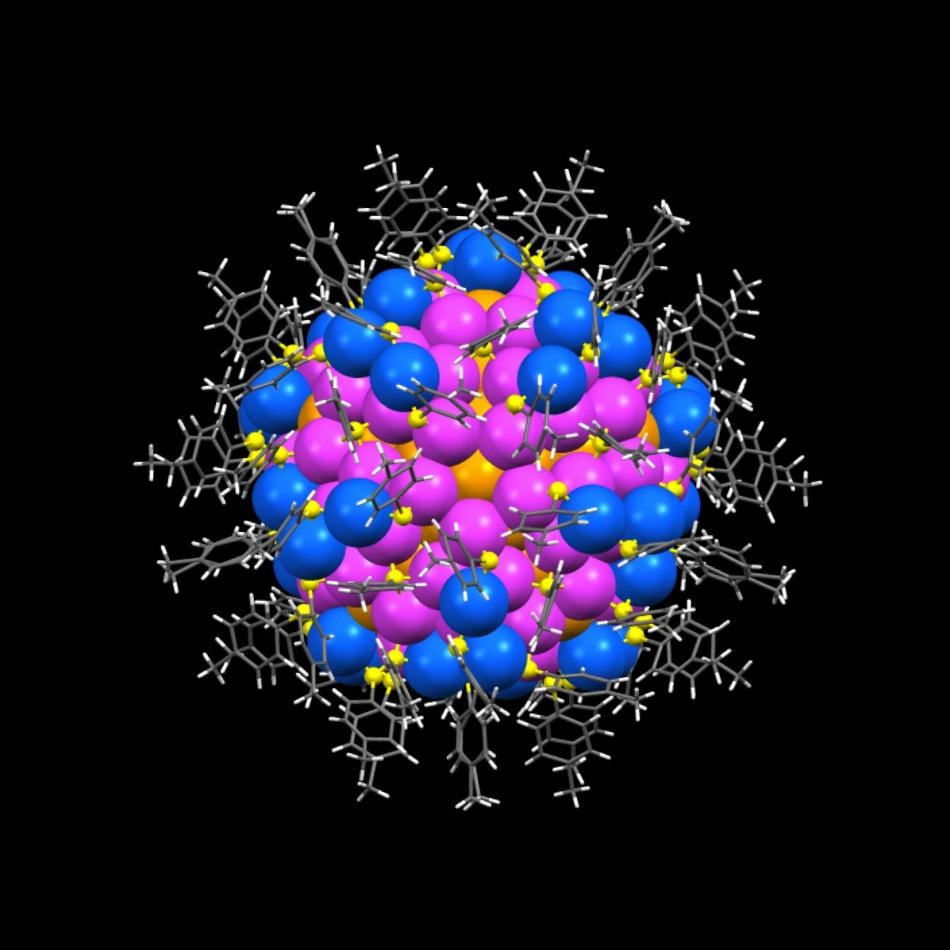Jan 24 2017
 The Structure of the Largest Gold Nanoparticle to-date, Au246(Sr)80, was Resolved Using X-Ray Crystallography. CREDIT: CARNEGIE MELLON UNIVERSITY
The Structure of the Largest Gold Nanoparticle to-date, Au246(Sr)80, was Resolved Using X-Ray Crystallography. CREDIT: CARNEGIE MELLON UNIVERSITY
A team of scientists from Carnegie Mellon University have demonstrated the capability of synthetic nanoparticles to obtain the same level of structural complexity, accuracy, and hierarchy as their natural counterparts, biomolecules. Featured in Science, this study also highlights the atomic-level mechanisms behind nanoparticle self-assembly.
The findings obtained from the lab of Chemistry Professor Rongchao Jin will enable researchers to improve their understanding on how nanoparticles develop, and will also help in assisting the construction of nanoparticles, including those capable of being used in the creation of new materials, fabrication of computer chips, and development of new drug delivery devices and drugs.
Most people think that nanoparticles are simple things, because they are so small. But when we look at nanoparticles at the atomic level, we found that they are full of wonders.
Rongchao Jin, Chemistry Professor, Carnegie Mellon University
Generally, nanoparticles are between 1 and 100 nm in size. Particles on the larger end of the nanoscale are difficult to produce precisely. For a decade, Jin extensively focused on developing precise gold nanoparticles, first by establishing the structure of an ultra-small Au25 nanocluster and then working on bigger ones.
In 2015, X-ray crystallography was used by Jin’s lab in order to establish the structure of an Au133 nanoparticle. The researchers discovered that it contained self-organized, complex patterns that were similar to those found in nature.
In the current study, the researchers focused on discovering the mechanisms that caused the formation of these patters. The team, headed by graduate student Chenjie Zeng, established the structure of Au246, considered to be one of the most complex and largest nanoparticles developed by scientists till date and the largest gold nanoparticle to have its structure established by X-ray crystallography.
Au246 was considered to be a suitable candidate for deciphering the complicated rules of self-assembly as it contains an appropriate number of atoms and surface ligands and is almost the same weight and size as a protein molecule.
A study on the structure of Au246 highlighted that the particles had much more in common with biomolecules than just size. The team further studied that ligands in the nanoparticles self-assembled into parallel and rotational patterns that are remarkably similar to the patterns detected in the secondary structure of proteins.
This could specify that nanoparticles of this size could effortlessly interact with biological systems, providing new avenues for drug discovery.
The team also discovered that Au246 particles develop by following two rules. They begin by maximizing the interactions between atoms, a mechanism that exists in theory but yet to be seen.
This is then followed by matching the nanoparticles with symmetric surface patterns, a mechanism that had not been considered earlier. The matching, which is more like puzzle pieces coming together, highlights the fact that the components of the particle can identify each other by their patterns and then spontaneously come together into a nanoparticle’s highly ordered structure.
"Self-assembly is an important way of construction in the nanoworld. Understanding the rules of self-assembly is critical to designing and building up complex nanoparticles with a wide-range of functionalities," said Zeng, the study's lead author.
Jin plans to push the crystallization restrictions of nanoparticles to much bigger particles in future studies. He also hopes to explore the electronic and catalytic power of the particles.
Carnegie Mellon graduate student Yuxiang Chen and the University of Toledo's Kristin Kirschbaum, a crystallographer, and Kelly J. Lambright are the additional authors of the study.
The Air Force Office of Scientific Research and Camille Dreyfus Teacher-Scholar Awards Program funded the study.